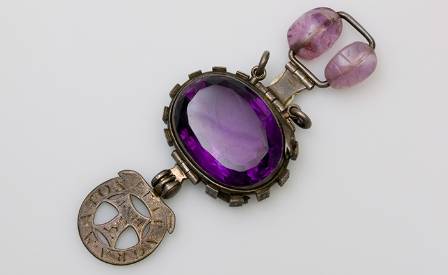 Submitted by Amethyst on
Submitted by Amethyst on

Derivative Images
Amethysts were used as charms by the ancient Greeks to prevent drunkenness. Medieval European soldiers used amethyst amulets as protection in battle as they believed the gem heals people and keeps them cool-headed. But this one has a different story. It is believed it was looted from the Temple of Indra in Cawnpore during the bloody Indian Mutiny of 1857. The Temple honored Indra, the Hindu king of gods, ruler of the heavens, god of thunder, rain and a great warrior god.

The cursed amethyst: faceted, oval, (3.5 x 2.5cm) mounted in a silver ring in the form of a snake, decorated with zodiacal plaques and with two hinged pendants, one of which bears two scarabs of amethystine quartz, the other a T in silver, engraved. The Mystery surrounding the Delhi Purple Sapphire was a case of mistaken identity. Th gem is not, in fact, a sapphire but actually an amethyst..
The jewel was brought into England by Colonel W. Ferris, a Bengal Cavalryman. The Colonel soon lost all his money and fell ill and so did his son when he inherited it. The next owner was a family friend who committed suicide. In 1890 it was bought by writer, scientist and Persian scholar Edward Heron-Allen.
Immediately after receiving it, Edward Heron-Allen claimed to have started having bad luck. So when friends asked for it, he happily gave it away.
The first friend “was thereupon overwhelmed by every possible disaster” and the other, a singer, lost her voice: “her voice was dead and gone and she has never sung since.” Heron-Allen then threw the amethyst into Regent’s Canal. But three months later it found its way back, returned by a dealer who had bought it from a dredger.
The Delhi Purple Sapphire is “accursed and is stained with the blood, and the dishonor of everyone who has ever owned it” he wrote. In 1904 after the birth of his first daughter he declared: “I feel that it is exerting a baleful influence over my newborn daughter”. So he shipped it, locked in a box, to his bankers with set instructions for it to be locked away until after his death.
And so it was for many decades until the mid-20th century when his daughted decided to donate it to the Natural History Museum, along with a letter of warning below which was written back in 1904.
To – Whomsoever shall be the future possessor of this Amethyst. These lines are addressed in mourning before he, or she, shall assume the responsibility of owning it.
This stone is trebly accursed and is stained with blood, and the dishonour of everyone who has ever owned it. It was looted from the treasure of the Temple of the God Indra at Cawnpore during the Indian mutiny in 1855 and brought to this country by Colonel W. Ferris of the Bengal Cavalry. From the day he possessed it he was unfortunate, and lost both health and money. His son who had it after his death, suffered the most persistent ill-fortune till I accepted the stone from him in 1890. He had given it once to a friend, but the friend shortly afterwards committed suicide and left it back to him by will.
From the moment I had it, misfortunes attacked me until I had it bound round with a double headed snake that had been a finger ring of Heydon the Astrologer, looped up with Zodiacal plaques and neutralized between Heydon’s magic Tau and two amethyst scaraboei of Queen Hatasu’s period, brought from Der el-Bahari (Thebes). It remained thus quietly until 1902, though not only I, but my wife, Professor Ross, W.H.Rider, and Mrs Hadden, frequently saw in my library the Hindu Yoga, who haunts the stone trying to get it back. He sits on his heels in a corner of the room, digging in the floor with his hands, as of searching for it.
In 1902, under protest I gave it to a friend, who was thereupon overwhelmed with every possible disaster. On my return from Egypt in 1903 I found she had returned it to me, and after another great misfortune had fallen on me I threw it into the Regent’s Canal. Three months afterwards it was bought back to me by a Wardour St. dealer who had bought if from a dredger. Then I gave it to a friend who was a singer, at her earnest wish. The next time she tried to sing, her voice was dead and she has never sung since.
I feel that it is exerting a baleful influence over my new born daughter so I am now packing it in seven boxes and depositing it at my bankers, with directions that it is not to see the light again until I have been dead thirty three years. Whoever shall open it, shall first read this warning, and then do so as he pleases with the Jewel. My advice to him or her is to cast it into the sea. I am forbidden by the Rosicrucian Oath to do this, or I would have done it long ago.
(Signed) Edward Heron-Allen
October 1904
The jewel is now housed safe and sound in The Vault gallery in the Natural History Museum of London which can be found at one end of the most fabulous wing or rocks and minerals as one can ever hope to see.
It must be said that the curators of the jewel aren’t entirely convinced by the tale of woe of this stone though that isn’t to say that there aren’t terrible similarities between the history listed above and what can be historically proven. Also it seems the curse is still alive and well so to speak as in 2004 the gem was in the possession of John Whittaker, a member of the Natural History Museum who was tasked with transporting the purple sapphire to the Heron-Allen Society for an event. During the journey, Mr Whittaker and his wife were engulfed in a dramatic thunderstorm, which trapped them in their car. Mr Whittaker claimed it to be the most horrific experience of his life.
Whittaker was tasked with transporting the Sapphire a second time, after which he fell violently sick with a stomach bug, and then a third time, when just before he was due to take the gem he fell in pain, finally passing a kidney stone.
Stephen Liddell - https://stephenliddell.co.uk/2018/09/10/the-tale-of-the-cursed-amethyst-at-the-natural-history-museum-in-london/
Posted for educational/imformational purposes only.
- 866 reads